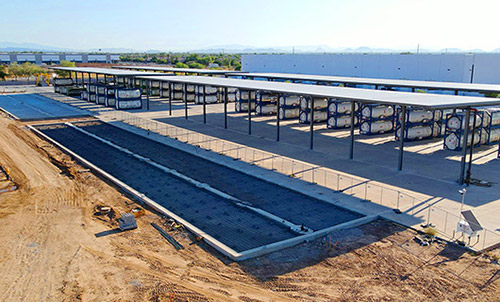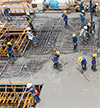Numerous factors have converged to build momentum and spur investment in manufacturing construction, creating a manufacturing renaissance in the United States. Various elements, such as supply chain complications, geopolitical unrest, energy costs, proximity to consumer bases, the impact of federal laws and funding initiatives, and emerging market dynamics influence this scenario.
While the broader economic landscape, monetary policy shifts, and prevailing market uncertainties have exerted varying degrees of influence on different industry sectors, capital investment in manufacturing facilities is strong. According to Census data, manufacturing-related construction hit a $210 billion annual rate in November 2023, more than triple the average rate in the 2010s. Deloitte recently reported that manufacturing construction spending had the most significant annual increase in construction spending (65.5 percent) as of August 2023.
According to Census data, manufacturing-related construction hit a $210 billion annual rate in November 2023. Key determinants influencing regional expansion trends in the manufacturing sector include land availability, cost-effective energy sources, robust logistics infrastructure, a conducive business climate, and a well-supported labor environment, as outlined in an industry analysis by Newmark.
According to the Newmark study, which analyzed significant manufacturing announcements in the U.S. over the past three years, nearly every state in the U.S. has benefited from recent announcements in manufacturing construction, with a notable focus in regions from the Midwest to the Southeast and Southwest. Texas and Arizona lead in investments, alongside Georgia and North Carolina. The study reveals substantial commitments in advanced manufacturing, totaling around $400 billion, expected to generate over 210,000 jobs and require constructing at least 250 million square feet by 2030. This manufacturing surge offers a timely boost to the construction industry amid a general slowdown in sectors like commercial, retail, and office construction due to economic factors.
Market Trends Driving Development in the U.S.
The impact of COVID-19 on the global supply chain played a pivotal role in accelerating the trend of reshoring manufacturing to the U.S. The pandemic exposed vulnerabilities in international supply chains, leading many companies to reevaluate their reliance on distant suppliers. Disruptions in the production and transportation of critical goods highlighted the advantages of having manufacturing operations closer to home. This realization and the need for resilient and flexible supply chains fueled the urgency to restore production to the United States.
Federal legislation and funding encouraging the construction of new facilities are adding fuel to the fire. The CHIPS and Science Act, the Infrastructure Investment and Jobs Act and the Inflation Reduction Act are just a few examples.
Megaproject announcements, characterized by budgets over $1 billion, have increased significantly. These projects stand out for their immense scale, complexity, and long duration, often involving sophisticated technology and organization. They significantly impact communities, economies, and the environment and require extensive economic development efforts, planning, and coordination among numerous stakeholders.
Several market sectors are experiencing growth, including:
- Semiconductors: The demand for semiconductors is surging, and the U.S. is striving to reduce reliance on foreign suppliers by boosting domestic semiconductor manufacturing. The CHIPS Act supports investment by foreign and domestic firms in new chip facilities and their supply chain.
- Electric vehicles: With the global shift toward electric vehicles, the U.S. is positioning itself as a significant hub for EV production, leading to increased construction of EV manufacturing plants, battery recycling facilities, and production facilities for suppliers serving this industry. The impact of COVID-19 on the global supply chain played a pivotal role in accelerating the trend of reshoring manufacturing to the U.S.
- Advanced manufacturing: Advanced manufacturing is utilizing innovative technologies and methodologies to improve products, processes, and production operations. By integrating information technology, automation, computation, software, sensing, and networking, advanced manufacturing paves the way for more innovative, safer, and more environmentally sustainable production processes.
- Data centers: The digital age relies heavily on data centers, and the U.S. is witnessing a boom in data center construction to support the growing demand for cloud computing, artificial intelligence (AI), and data storage. While not technically manufacturing, data centers provide the backbone of data and communications. Life sciences: The pandemic underscored the importance of domestic pharmaceutical and medical supply production. Additionally, advances in research and development have led to new RNA and other medications.
- Energy: The evolution of the U.S. energy sector, primarily driven by the extensive implementation of hydraulic fracking in the early 2000s, marked a crucial turning point, igniting the drive to revitalize manufacturing. The transition from fossil fuels to more sustainable power generation sources has led to capital investments in manufacturing facilities to produce equipment for renewable energy generation, such as solar panels, batteries, hydrogen fuel cells, and other technologies.
Manufacturing in the United States offers companies several benefits, including:
- Political stability: The United States, relative to other regions, boasts a stable political environment, providing a secure foundation for thriving businesses. The Russia-Ukraine war and tensions between China and Taiwan are two examples of international instability. The relative stability of the U.S. fosters investor confidence and reduces risks associated with manufacturing operations.
- Access to reliable power: The U.S. offers a robust and reliable power infrastructure, ensuring uninterrupted production processes. This reliability is critical for manufacturing operations dependent on a consistent energy supply.
- Skilled workforce: The U.S. has a highly skilled and adaptable workforce. Access to a skilled labor pool enables manufacturers to innovate and remain competitive in the global market. The passage of the Infrastructure Investment and Jobs Act, CHIPS and Science Act, and Inflation Reduction Act has notably enhanced the domestic manufacturing construction sector.
- Proximity to clients: Manufacturing in the U.S. often means being closer to the consumer base. Reduced shipping costs and transit times make it advantageous for companies to manufacture products locally.
- Federal legislation and funding bills: The U.S. government has recognized the importance of manufacturing and has taken measures to incentivize companies to invest in domestic production. Federal legislation and funding bills provide grants, tax incentives, and other financial support to companies willing to bring production back to the U.S. The passage of the Infrastructure Investment and Jobs Act, CHIPS and Science Act, and Inflation Reduction Act has notably enhanced the domestic manufacturing construction sector.
- Automation: The U.S. is investing in automated production at a rapid pace. While robots require significant upfront capital investment, they can now build things more cheaply than workers can. The cost of automation is similar everywhere in the world. Automated manufacturing in the U.S. eliminates the strategic advantage of cheap labor from international competitors. Industries dependent on cheap labor as a strategic advantage will see their businesses disrupted by robotic automation, paving the way for a resurgence in U.S. manufacturing.
- Buy America: Several of the federal funding programs also include “Buy America” clauses, which mandate that a certain portion of materials are sourced from the U.S., or that final assembly must be completed in the U.S. This is also driving reshoring and investment in the states.




